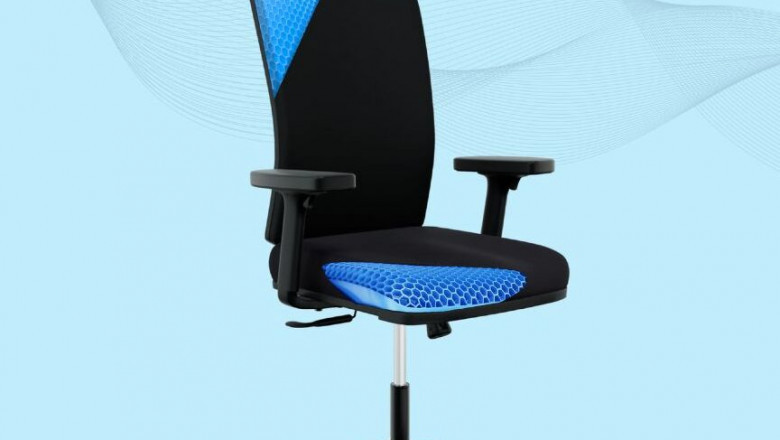views
For decades, the humble office chair has been a static fixture in our workspaces, its primary function to provide a place to sit. While ergonomic design has made significant strides in recent years, a revolutionary shift is now underway, poised to transform the chair from a mere piece of furniture into an intelligent, interactive hub for health, productivity, and sustainability. This transformation is driven by the very concept of "smart grids," extending their influence beyond city-wide power distribution to the micro-level of our personal workspaces.
When we speak of "smart grids powering your office chair," it's not about a direct electrical current from a national grid to inflate your lumbar support. Instead, it encapsulates a multi-faceted integration of intelligent design, sensor technology, and connectivity within an interconnected office ecosystem.
It's about harnessing the principles of data exchange, automation, and optimized resource management that define smart grids, applying them to enhance our ergonomic experience and contribute to a more efficient and sustainable workspace.
At the heart of this ergonomic evolution lies the integration of advanced materials and embedded intelligence. Consider the "SmartGRID" technologies already emerging in some ergonomic chairs, like those from companies prioritizing adaptive comfort. These aren't connected to the electrical grid, but rather represent a "smart" design philosophy. They utilize proprietary polymer grids or engineered structures that dynamically respond to body pressure, distributing weight evenly and providing localized support where needed most.
Unlike traditional foam or spring systems, these materials offer superior breathability, pressure relief, and long-term resilience, significantly reducing discomfort and promoting better posture during prolonged sitting hours. This intrinsic "intelligence" within the material itself represents a foundational layer of the ergonomic evolution.
However, the true "smart grid" connection comes into play when these chairs are equipped with sophisticated sensors and become part of a larger intelligent building network. Imagine a chair embedded with pressure sensors, accelerometers, and even biometric monitors.
These sensors can continuously track your posture, sitting duration, movement patterns, and even subtle changes in your body's interaction with the chair. This real-time data, much like the flow of information in a city-wide smart grid, becomes the "power" that drives the next generation of ergonomic benefits:
Firstly, proactive posture correction and personalized adjustments become a reality. If the chair detects you're slouching or holding an unhealthy posture for an extended period, it won't just offer a static adjustment. Through its connection to the office's smart grid, it could provide gentle haptic feedback – a subtle vibration or pressure change – to remind you to adjust. Beyond mere reminders, the chair's motorized components, powered by the localized smart grid, could subtly shift to encourage a better sitting position, guiding you toward optimal spinal alignment.

This personalized approach means the chair adapts to you, rather than you adapting to the chair. Furthermore, your preferred ergonomic settings – seat height, recline angle, lumbar firmness – could be stored and retrieved, allowing the chair to automatically adjust when you sit down, whether it's your personal chair or a hot-desking unit.
Secondly, the integration extends to enhanced wellness and productivity. The data collected by smart chairs can be invaluable for individual well-being. Coupled with privacy-compliant analytics, this information could be presented on a connected app, offering insights into your sitting habits, suggesting breaks, recommending stretching exercises, or even integrating with personal fitness trackers to provide a holistic view of your daily activity.
For businesses, this data, when anonymized and aggregated, can offer insights into workspace utilization, identify potential ergonomic issues across the workforce, and inform proactive measures to improve employee health and reduce absenteeism.
Thirdly, the smart grid connection brings significant advantages in energy efficiency and building management. A chair that knows whether it's occupied or not can communicate this information directly to the building's management system (BMS). If a chair remains empty for a prolonged period, it can trigger localized energy-saving actions: dimming nearby lights, adjusting HVAC settings in unoccupied zones, or entering a low-power "sleep" mode itself.
This granular level of occupancy sensing, facilitated by smart chairs as nodes in the office's micro-grid, contributes significantly to overall energy conservation and reduces the building's carbon footprint – a critical consideration for sustainable businesses globally.
Looking ahead, the "smart grid powered" office chair will likely integrate further with the Internet of Things (IoT) in the workspace. Imagine a chair that automatically adjusts your desk height when you sit down, or one that triggers a personalized lighting scheme based on your preferences and the time of day.
Predictive maintenance, another hallmark of smart grid systems, could also be applied to office chairs, with sensors monitoring wear and tear on components, proactively scheduling maintenance to ensure longevity and consistent ergonomic performance.
In conclusion, the ergonomic evolution of the office chair is being fundamentally reshaped by the principles of smart grids. It moves beyond passive support to active engagement, leveraging data, connectivity, and automation to create a dynamic, personalized, and energy-efficient seating experience.






















Comments
0 comment